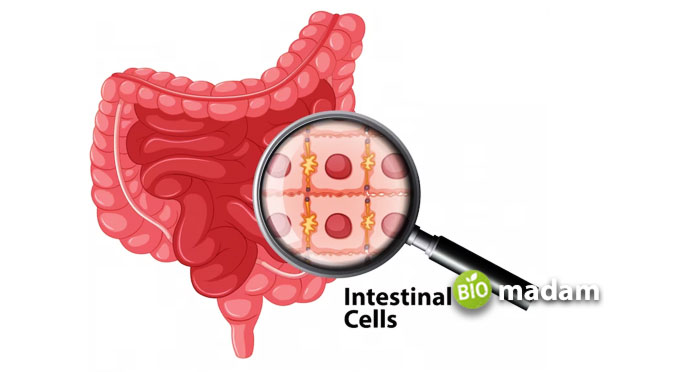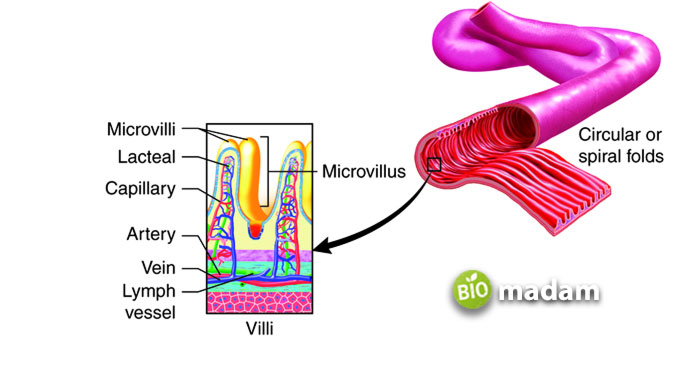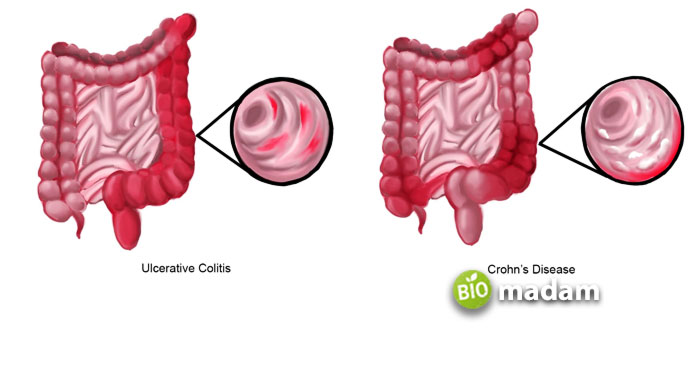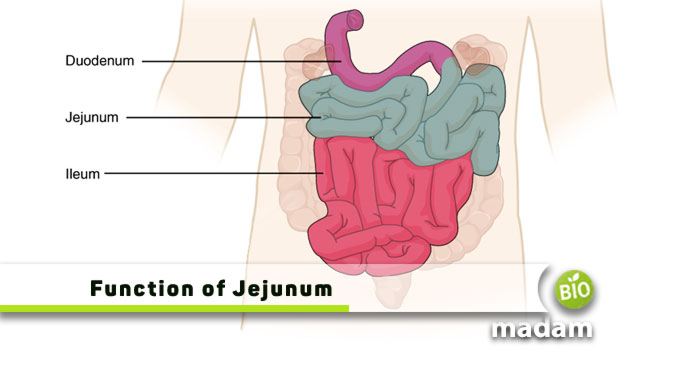You must have gone through different types of ecologies surrounding our biomes and ecosystems. Living organisms, including plants, animals, fungi, etc., are present everywhere around the globe, and to know about their interrelationship, it’s important to study them in detail. Human beings are one such species with a complex organ system. The human body contains a vast network of the digestive system, including the esophagus, stomach, small and large intestines, etc. These organs function synergistically to provide the body with essential nutrients.
The small intestine lies between the stomach and large intestine to perform major nutrient-absorbing functions for the body. It covers approximately 20 to 25 feet of the entire digestive system, with three sub-parts. These are duodenum, jejunum, and ileum.
What is the Jejunum?
Jejunum is observed to be the second or the central part of the small intestine that lies between the duodenum and ileum. An adult human comprises an almost 25 feet long small intestine, of which the jejunum consumes two-fifth. The word jejunum is derived from the Latin word “jejunus,” meaning “hungry” or “empty of food.” This Latin term also refers to the meaning that this specific part always lacks nutritional value and absorbs whatever nutrient is coming in the way. Higher vertebrates like mammals, reptiles, and human beings acquire this part. The food that comes digested from the duodenum enters the jejunum, which is further absorbed with the help of special structures.
Let’s continue reading the details below to understand more about the functions and anatomy of the jejunum.
Digestive Functions of Jejunum
As the jejunum is the middle part of the small intestine, it holds great significance. Jejunum has to take chyme from the stomach and duodenum and break it down to move to the ileum part. Thus, the digestive system cannot work without this specific part of the small intestine. Important functions of jejunum include:

Enzyme Secretion
The mucosal layer of the jejunum is responsible for secreting various digestive enzymes for better absorption. The enzymes secreted here are sucrase, peptidase, lactase, enterokinase, etc. When the lubricated food travels down from the duodenum to the jejunum, these enzymes help them break down into smaller, simpler forms for easy absorption.
Absorption of Nutrients
Jejunum is entitled to be the primary site of nutrient absorption in the digestive tract. All the essential carbs, proteins, and fats are absorbed here. There are tiny, finger-like, numerous projections in the jejunum called villi. These structures increase the surface area, thus providing better room for absorption and digestion of the lipophilic content. Besides, it is also the major site of absorption for vitamin folic acid, minerals, and water.
Transportation of Nutrients
The liver is connected to the small intestine and other organs to get nutrient-rich blood and perform its liver functions. Jejunum, from the small intestine, plays a part here. It sends the absorbed nutrient to the liver via the hepatic portal vein, where the food is further processed to be distributed throughout the body.
Regulation Through Hormones
Like the duodenum, the jejunum also releases a hormone to regulate the digestive system. It releases cholecystokinin (CCK), which helps stimulate the enzyme secretions from the pancreas and bile from the gallbladder.
Anatomy of the Jejunum
The histological pattern of the jejunum is almost similar to the entire small intestine. It has four layers: the mucosa, submucosa, muscularis, and serosa. These all have distinct functions that work together to give the organ its function.

Mucosa
The innermost layer surrounds the hollow lumen and secretes some essential digestive enzymes. Special structures called villi and microvilli are present on the mucosal layer that helps increase the surface area to provide better space for carbs, proteins, vitamins, and minerals absorption. This layer has good contact between the jejunum and chyme through goblet cells, thus lubricating the area for absorption and protecting the walls of the intestine.
Submucosa
After the mucosa is the submucosa layer present. It is a middle layer to support and protect other layers. Submucosa typically consists of connective tissues surrounded by a network of blood vessels and lymph nodes. This complex network system provides essential nutrients and oxygen and transmits nerve signals to other jejunum tissues.
Muscularis
The next layer is named muscularis, which encircles the submucosa. Smooth muscle tissues in this layer allow food movement and further propel it to the next part.
Serosa
Finally, the last layer, the serosa, is simply made of squamous epithelial tissues. Serosa functions by secreting slippery liquid, also called serous fluid. This fluid lubricates the area and protects it from friction between other organs of the abdominal cavity.
Health Conditions Associated with Jejunum

The changes in the anatomy and physiology of this specific part of the small intestine can lead to several diseases and disorders. The following are the most prominent of them:
Celiac Disease and Lactose Intolerance: We know that jejunum plays a crucial role in absorbing essential micro and macronutrients. But, malabsorption conditions like celiac disease or lactose intolerance directly disturb the functioning of the jejunum. It results in bloating, diarrhea, and weight loss, thus ultimately reducing absorption.
Jejunal Diverticulosis: It is a condition where small pathological pouches grow in the walls of the jejunum. It is a rare but chronic condition that shows signs and symptoms like bloating, irregular bowel movement, and severe abdominal pain.
Jejunoileitis: It is an inflammatory bowel disease that can cause abrupt weight loss, diarrhea, and abdominal pain. Jejunoileitis is a form of Crohn’s disease, but other causes of this inflammation are bacterial infections, medication overuse, lymphoma, etc.
Other underlying diseases or conditions could affect the working of the jejunum, such as ischemia, cancer of the intestine, intestinal obstruction due to stones, cysts, or tumors, etc.
The Bottom Line
Just like any other body organ, the small intestine has its own importance. All three of its parts, including the duodenum, jejunum, and ileum, play particular roles in the digestion and absorption of food. After the food is fully broken down into smaller particles, the leftover is transferred to the large intestine for the following process. Overall, the digestive system is one of the body’s most essential systems besides the circulatory, nervous, reproductive, and skeletal systems.
FAQs
What is a unique feature of the jejunum?
Jejunum naturally has a thick mucosal wall lining, large diameter, and longer pathways for better absorption of nutrients. These distinguishing features make the jejunum an essential part of the small intestine.
Can you live without your jejunum?
A human body can somehow survive without a stomach or large intestine, but it’s relatively harder to live with removed jejunum. If the parts of the small intestine are damaged or removed, the essential nutrients are directly transferred to blood and plasma via the intravenous route.
What is the maximum capacity of jejunum?
Jejunum is responsible for absorbing nutrients to provide maximum energy to the body. The absorption capacity ranges from 0.66 to 0.94 kcal. Despite the difference in nutrient quantities from the stomach, the amount of energy remains almost the same.
How long does the food stay in the jejunum?
The small intestine is actively mixing food particles and adding lubricating fluids to help absorb them. Jejunum is part of the small intestine where most nutrient absorption occurs; thus, the food stays there for two to six hours.
What causes the inflammation of the jejunum?
There are several reasons that can inflame the jejunum. These include viral or bacterial infections, food poisoning, drug overdose, and underlying diseases like Ulcerative Colitis or Crohn’s disease.
What is the most common tumor of the jejunum?
Doctors have diagnosed several benign and malignant jejunal tumors, such as lipomas, GI stromal tumors, adenomas, etc. But the most common is the type of small bowel cancer called adenocarcinoma.

Anna has completed her degree in Pharmacy from the University of Hawaii. She is serving as a research assistant in a pharmaceutical company. She had a great interest in writing blogs, traveling to different parts of the US, and trying delicious recipes in her spare time.


I’m Soo impressed the app is very good 👍
Thankyou for appreciating!